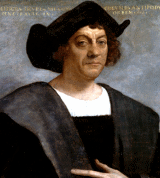
1492 Spain and Christopher Columbus sign the Capitulations of Santa Fe for his voyage to Asia to acquire spices.
1492 Spain gives Christopher Columbus his commission of exploration.
1492 Christopher Columbus sets sail from Palos de la Frontera, Spain.
1492 Christopher Columbus sails from La Gomera in the Canary Islands, his final port of call before crossing the Atlantic for the first time.
1492 Christopher Columbus's expedition makes landfall in the Caribbean, specifically in The Bahamas. The explorer believes he has reached South Asia
1492 Christopher Columbus becomes the first European to set foot on the island of Hispaniola, now Haiti and the Dominican Republic.
1493 Christopher Columbus leaves the New World, ending his first journey.
1493 Explorer Christopher Columbus arrives back in Lisbon, Portugal, aboard his ship Niña from his voyage to what is now The Bahamas and other islands in the Caribbean.
1493 Christopher Columbus returns to Spain after his first trip to the Americas.
1493 Christopher Columbus first sights the island of Dominica in the Caribbean Sea.
1493 Christopher Columbus first sights the island now known as Puerto Rico.
1493 Christopher Columbus goes ashore on an island he first saw the day before. He names it San Juan Bautista (later renamed Puerto Rico).
1494 Christopher Columbus lands in Jamaica.
1494 Christopher Columbus lands on the island of Jamaica and claims it for Spain.
1498 On his third voyage to the Western Hemisphere, Christopher Columbus becomes the first European to discover the island of Trinidad.
1498 Christopher Columbus becomes the first European to visit what is now Venezuela.
1502 Christopher Columbus leaves Spain for his fourth and final journey to the New World.
1502 Christopher Columbus leaves for his fourth and final voyage to the West Indies.
1502 Christopher Columbus lands at Guanaja in the Bay Islands off the coast of Honduras during his fourth voyage.
1502 Christopher Columbus lands at Costa Rica on his fourth, and final, voyage.
1503 Christopher Columbus visits the Cayman Islands and names them ''Las Tortugas'' after the numerous turtles there.
1504 Christopher Columbus uses his knowledge of a lunar eclipse that night to convince Native Americans to provide him with supplies.

